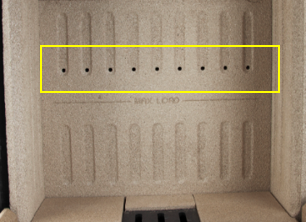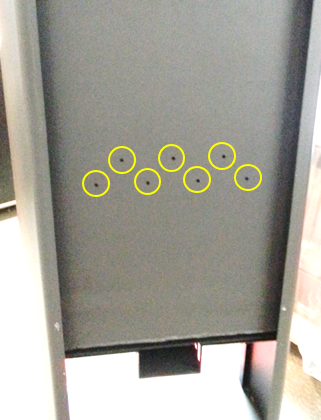Check the draft:
Check that your installation is done according to the instructions in the manual. The ideal draft is around 12Pa. If the draft is too high is often possible to hear wind howling coming from the stove. If this is the case, we recommend the Installation of a damper in the flue pipe or chimney. Consult a certified installer for further information.
If the draft is not excessive, it’s possible to reduce the noise trying one of the following:
1. If the noise comes from the fire chamber:
ALIGN the vermiculite back plate:
In a few cases, the particular features of the installation can cause a whistling noise coming from the fire chamber. The stove is built with very tight tollerances. If the holes and air vents in the stove are at a ”strange angle”, this might create a whistling noise.
You will need a thin screwdriver or a small piece of metal (size of a small coin)
Insert the screwdriver in the holes in the vermiculite back plate and make sure that they are aligned with the holes in the frame of the fire chamber.
The screwdriver should be able to go inside and around without any obstruction.
Alternatively, it is possible to reduce the noise by slightly raising the vermiculite back plate 2 mm sideways and/or up using a small piece of metal. To do so, follow the procedure to remove the firebricks and carefully lift or remove the back plate. Place the metal piece and put the back plate in its original location.

2. If the noise comes from the back:
Smoothen the edges of the tertiary holes:
In a few cases, the particular features of the installation can cause a whistling noise coming from behind the stove. This is due to the flow of air in the tertiary holes. To decrease the noise do as follows:
- Locate the back plate screws on your stove. Most stoves are fitted with a removable back plate, hold in position by screws. Screws are usually on the top and bottom part of the back plate.
- Untight the screws and remove the back plate. You will need light sandpaper or heat resistant tape:
- Using light sandpaper, file on and around the tertiary holes in the back of the stove.
- Alternatively, use heat resistant tape to cover the holes. Use a screwdriver or a marking knife to punch a hole in the tape to allow the flow of air in the holes. Make sure to cut the tape so that the holes are of the same dimension of the original ones.
- Put the baffle place in it's initial position

3. If the noise comes from the bottom:
Loosen the primary air damper bolt:
In a few cases, the particular features of the installation can cause a whistling noise coming from the bottom of the stove. This is due to the flow of air in primary air damper. To decrease the noise do as follow:
- Locate primary air damper in your stove. Most stoves are fitted with the primary air in the bottom/front part. The damper is the same used to activate the Aduro Tronic. To access the screw holding the damper , open the door and remove the ash drawer.
- Loosen the screw slightly. This will increase the space between the damper and the stove, possibly reducing the noise.
4. If the noise comes from the top:
Remove obstructions from secondary air:
In a few cases, the particular features of the installation can cause a whistling noise coming from behind. This is due to obstructions in the secondary air vents. To decrease the noise do as follows:
- Using a flashlight, check that the secondary air intakes are not obstructed. The regulation dampers lever should move back and forth freely and without much friction.
- If there is an obstruction or the regulation dampers can’t move freely, remove the obstruction and clean from all ash and residual. Lubricate the lever with high temperature copper grease/aluminium paste.
5. If the noise comes from multiple places:
Fit a flue damper:
In a few cases, the pa...


